前言
这个系列的前两节分别分析了 View 和 ViewGroup 中的事件分发,Android 中的事件分发还涉及到 Activity。但是内容过于简单,就不详细分析了,本节我们学习下 View 的 scrollTo、scrollBy 以及滑动辅助 Scroller。
Demo
正文开始之前我们先看一个 Demo。
public class MainActivity extends AppCompatActivity {
static final String TAG = "ScrollDemo";
@Override
protected void onCreate(Bundle savedInstanceState) {
super.onCreate(savedInstanceState);
setContentView(R.layout.activity_main);
final TextView textView = findViewById(R.id.text);
final LinearLayout linearLayout = findViewById(R.id.line1);
findViewById(R.id.btn_scroll_to).setOnClickListener(new View.OnClickListener() {
@Override
public void onClick(View v) {
linearLayout.scrollTo(-200,-200);
}
});
findViewById(R.id.btn_scroll_by).setOnClickListener(new View.OnClickListener() {
@Override
public void onClick(View v) {
linearLayout.scrollBy(-50,-50);
}
});
}
}
<?xml version="1.0" encoding="utf-8"?>
<LinearLayout xmlns:android="http://schemas.android.com/apk/res/android"
android:layout_width="match_parent"
android:layout_height="match_parent"
android:orientation="vertical">
<Button
android:id="@+id/btn_scroll_to"
android:layout_width="match_parent"
android:layout_height="wrap_content"
android:text="Scroll to" />
<Button
android:id="@+id/btn_scroll_by"
android:layout_width="match_parent"
android:layout_height="wrap_content"
android:text="Scroll by" />
<LinearLayout
android:id="@+id/line1"
android:layout_width="match_parent"
android:layout_height="match_parent"
android:background="#ff0000">
<TextView
android:id="@+id/text"
android:layout_width="match_parent"
android:layout_height="200dp"
android:background="#00ff00"
android:gravity="center"
android:text="不要玩我" />
</LinearLayout>
</LinearLayout>
很简单,页面中有两个按钮,一个 LinearLayout 和一个 TextView,点击按钮对 LinearLayout 进行 Scroll 操作,结果如下:
scrollTo
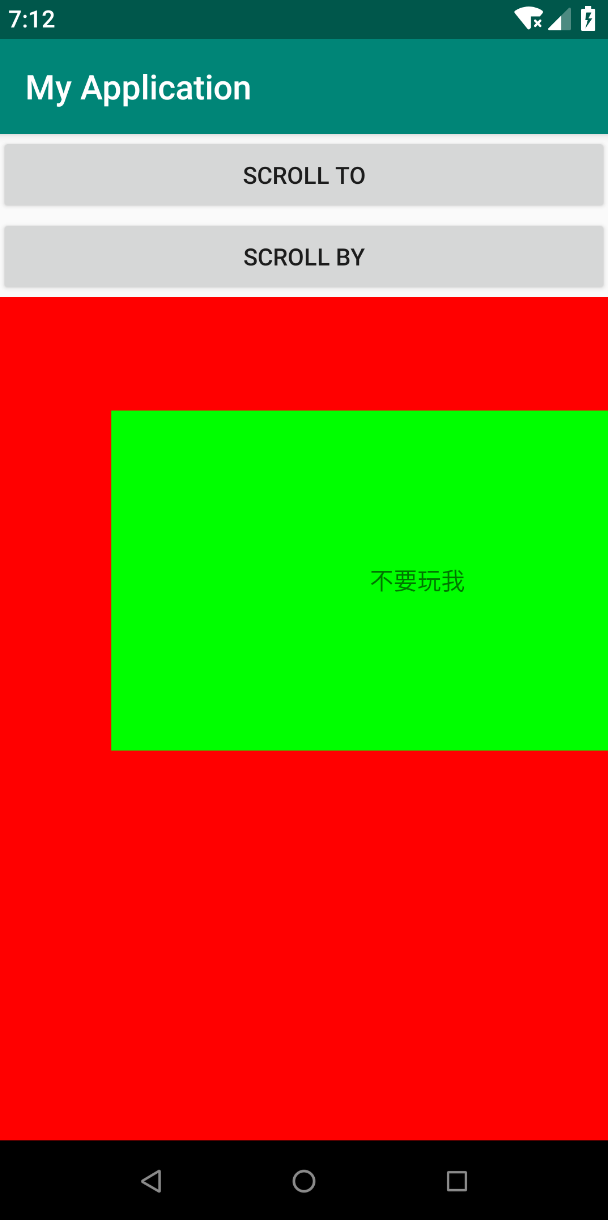
scrollBy
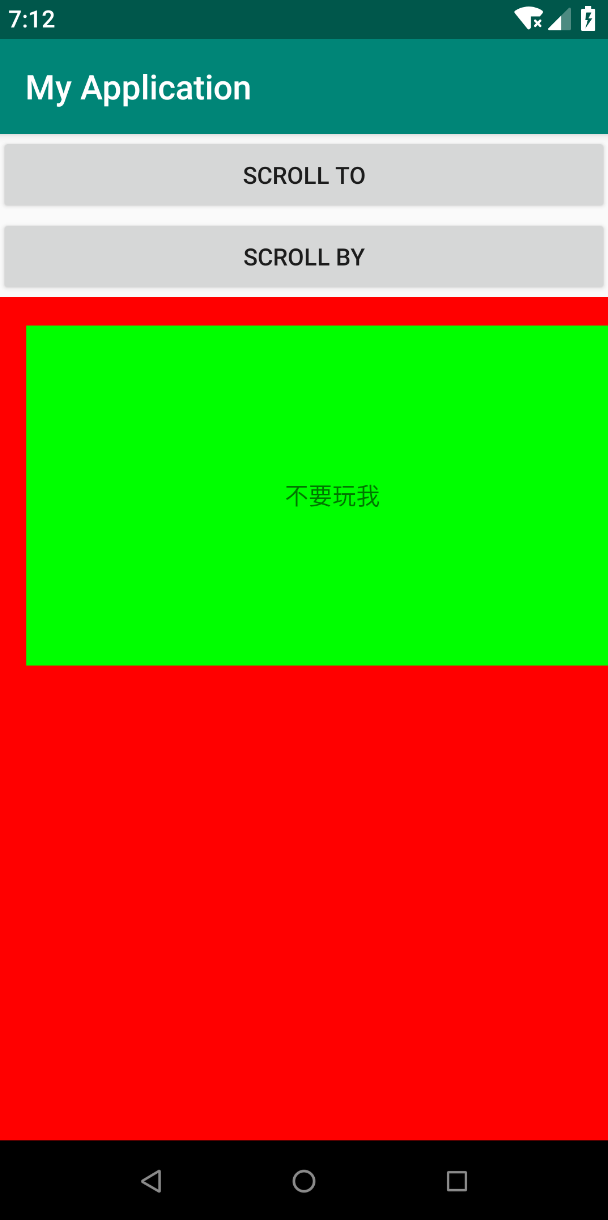
scrollTo 之后 scrollBy

scrollBy n 次之后 scrollTo
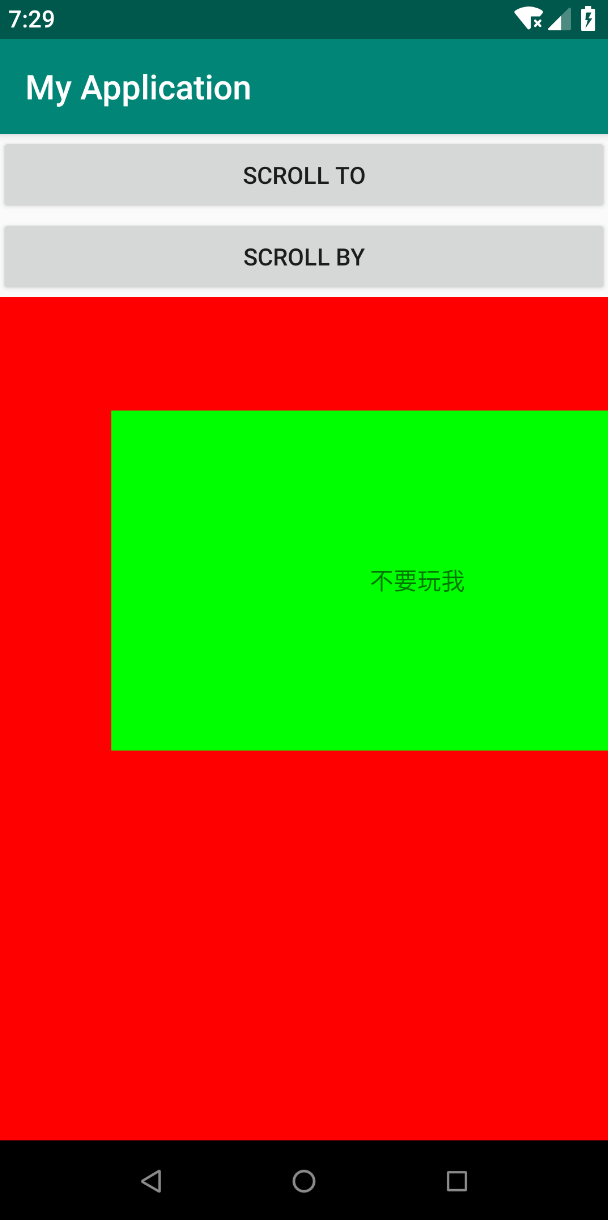
然后修改代码,将事件作用到 TextView,再看下效果。
findViewById(R.id.btn_scroll_to).setOnClickListener(new View.OnClickListener() {
@Override
public void onClick(View v) {
textView.scrollTo(-200,-200);
}
});
findViewById(R.id.btn_scroll_by).setOnClickListener(new View.OnClickListener() {
@Override
public void onClick(View v) {
textView.scrollBy(-50,-50);
}
});
scrollTo
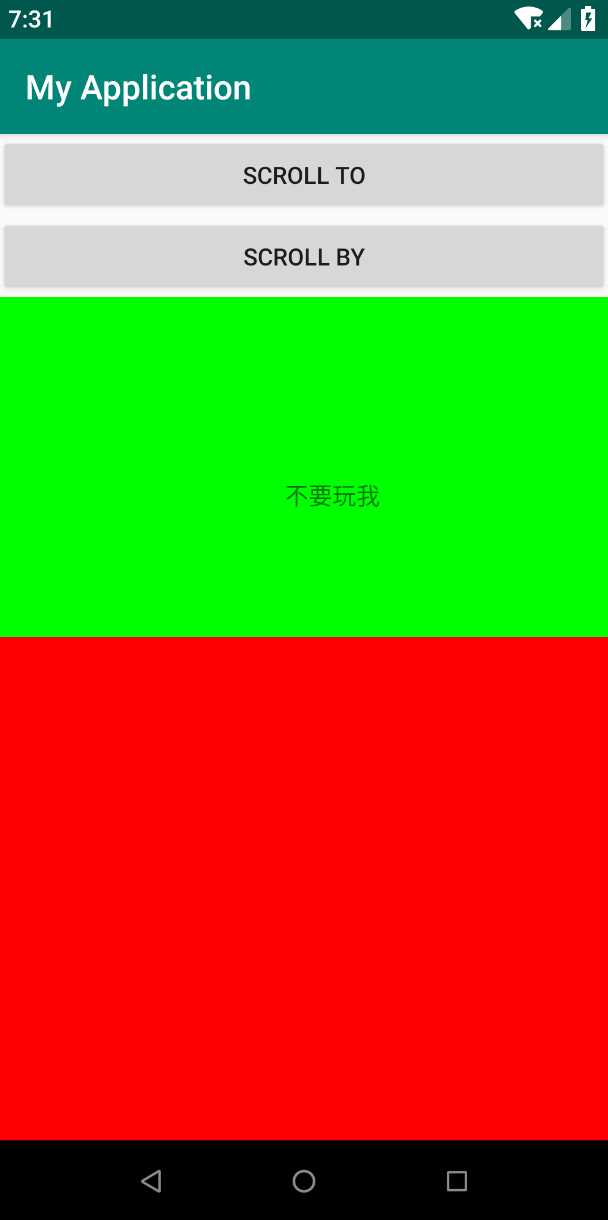
scrollBy
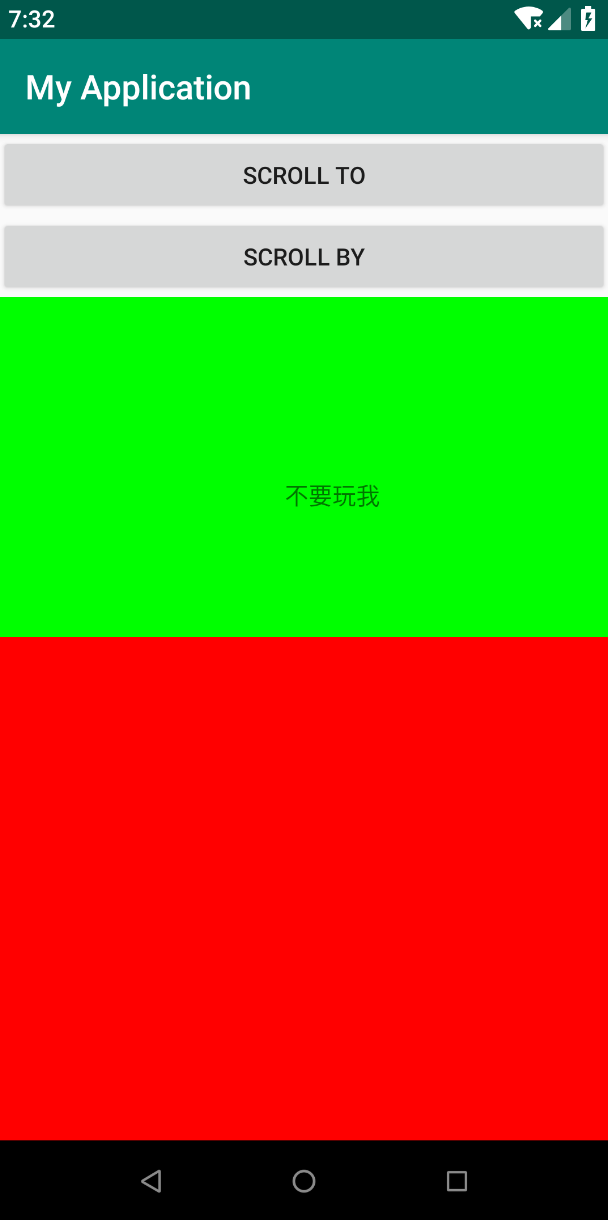
scrollTo 之后 scrollBy
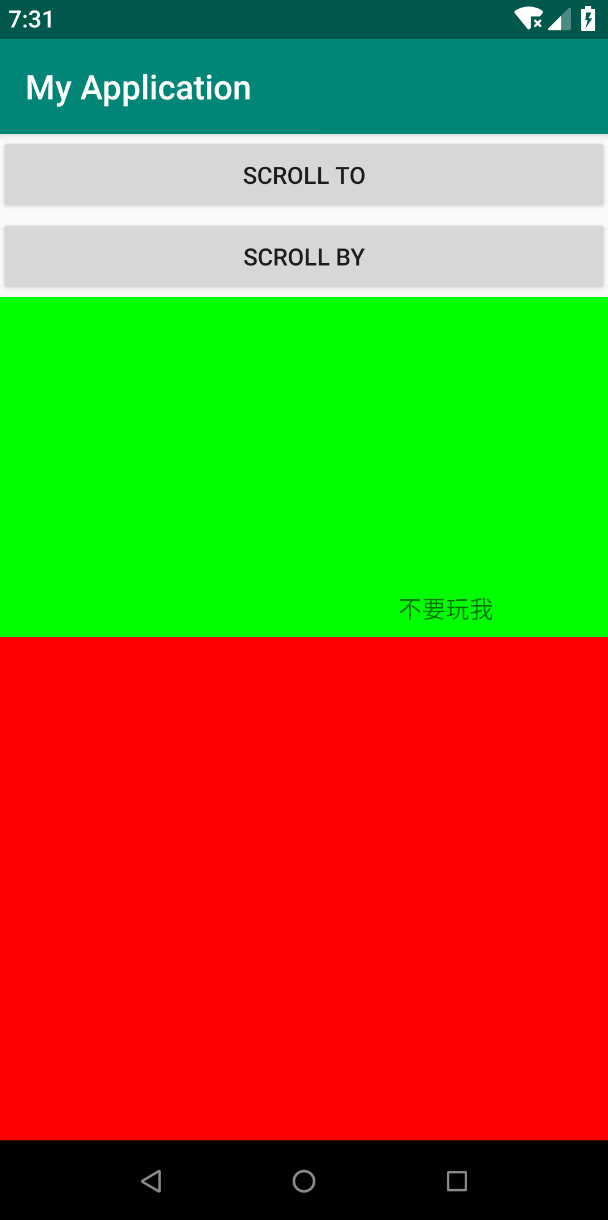
scrollBy n 次之后 scrollTo
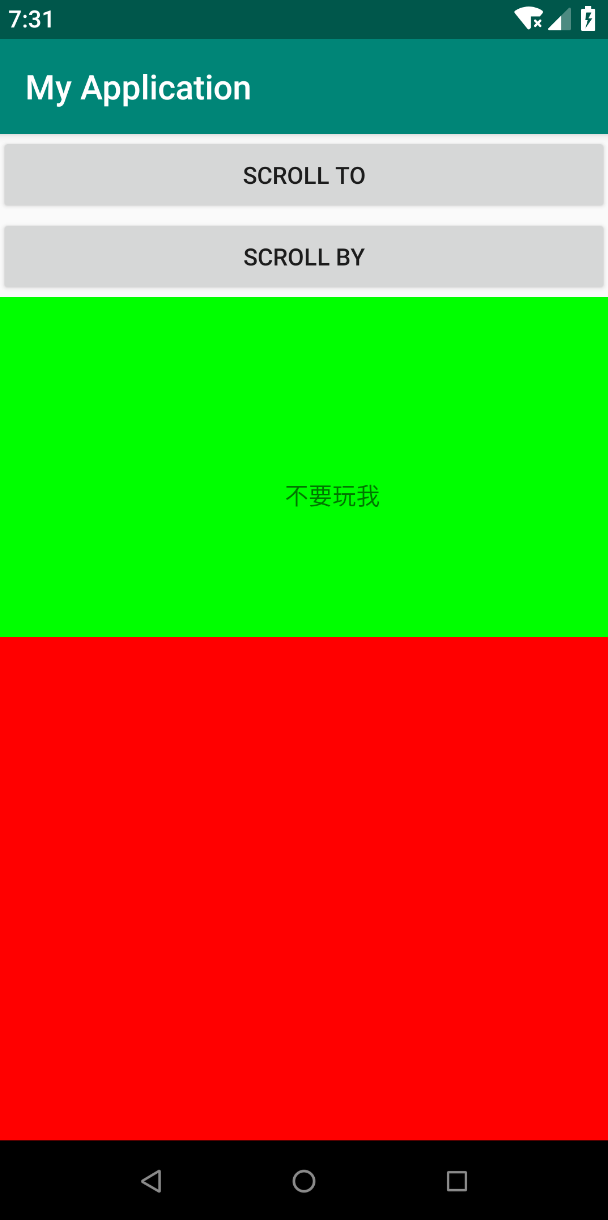
其中可以看到 scrollTo 是根据绝对位置进行位移,也就是说不论 View 当前处于哪个位置,它的新坐标都是根据原点坐标计算出来的。 scrollBy 是根据相对位置进行移动,也就是根据现在 View 的坐标在进行一定距离的移动。
看了上面的 Demo,有两点比较奇怪:
- scrollTo 和 scrollBy 的参数都是填的负值,但是都是向右下移动,这和 Android 坐标系中左上是坐标原点不符。
- LinearLayout scroll 的时候,它的子 View TextView 发生了位移。TextView scroll 的时候,它自己的位置没有动,其中的内容发生了位移。
带着上面我们观察到的效果和疑问,我们看一下官方文档和源码:
官方文档
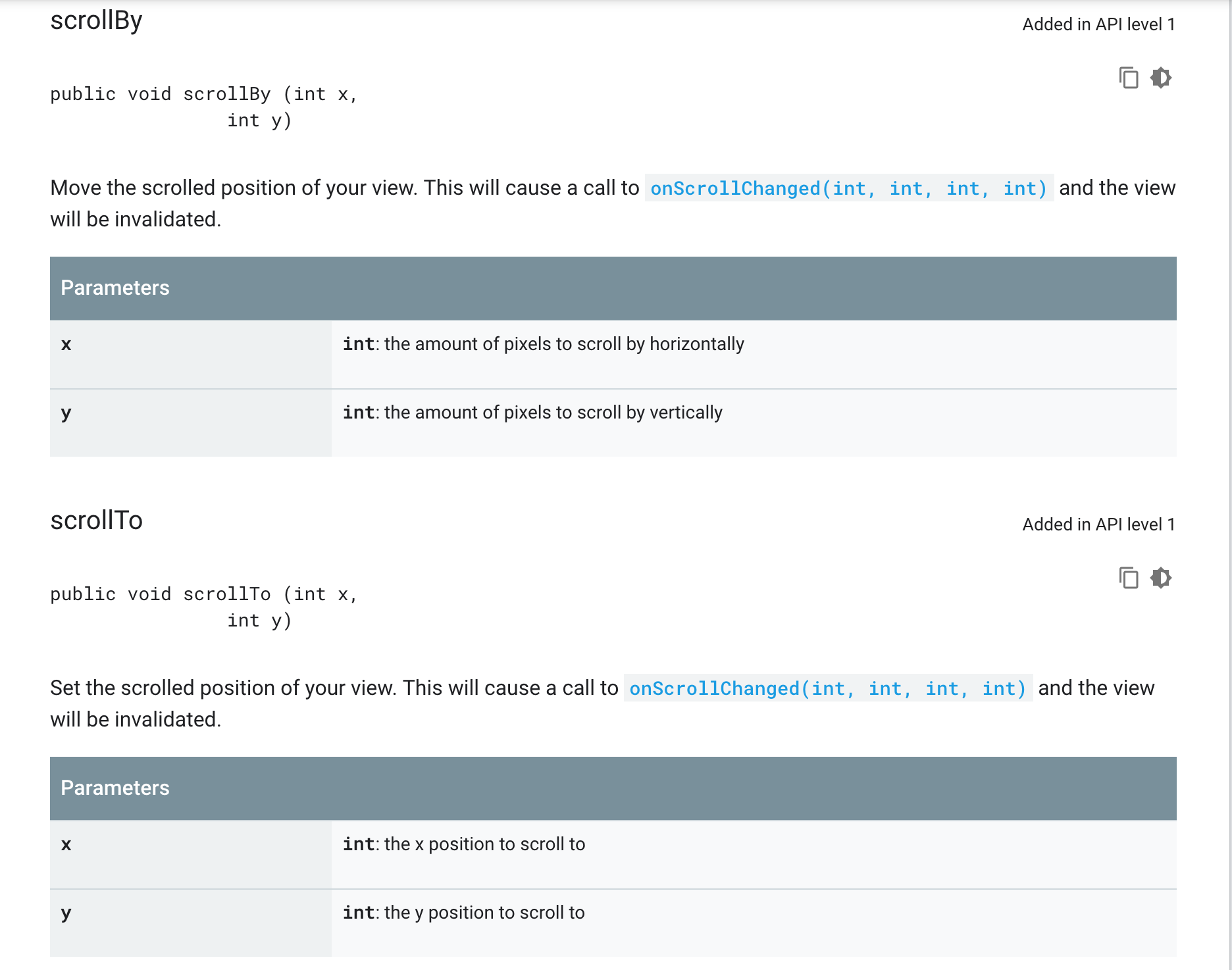
注意官方文档的用此非常精妙 Set 和 Move。Set 就是给 View 设定一个位置而 Move 相当于移动一定距离。
源码
View#scrollBy
public void scrollBy(int x, int y) {
scrollTo(mScrollX + x, mScrollY + y);
}
View#scrollTo
public void scrollTo(int x, int y) {
if (mScrollX != x || mScrollY != y) {
int oldX = mScrollX;
int oldY = mScrollY;
mScrollX = x;
mScrollY = y;
invalidateParentCaches();
onScrollChanged(mScrollX, mScrollY, oldX, oldY);
if (!awakenScrollBars()) {
postInvalidateOnAnimation();
}
}
}
可以看到 scrollBy 也是调用 scrollTo 实现,下面我们重点分析 scrollTo。
其中有两个很重要的参数 mScrollX 和 mScrollY:
/**
* The offset, in pixels, by which the content of this view is scrolled
* horizontally.
* {@hide}
*/
@ViewDebug.ExportedProperty(category = "scrolling")
protected int mScrollX;
/**
* The offset, in pixels, by which the content of this view is scrolled
* vertically.
* {@hide}
*/
@ViewDebug.ExportedProperty(category = "scrolling")
protected int mScrollY;
/**
* Set the horizontal scrolled position of your view. This will cause a call to
* {@link #onScrollChanged(int, int, int, int)} and the view will be
* invalidated.
* @param value the x position to scroll to
*/
public void setScrollX(int value) {
scrollTo(value, mScrollY);
}
/**
* Set the vertical scrolled position of your view. This will cause a call to
* {@link #onScrollChanged(int, int, int, int)} and the view will be
* invalidated.
* @param value the y position to scroll to
*/
public void setScrollY(int value) {
scrollTo(mScrollX, value);
}
可以看到注释中有这样一段话:
The offset, in pixels, by which the content of this view is scrolled
这句话解释了当我们使用 scrollTo 或 scrollBy 的时候为什么移动的不是控件本身而是控件中的内容。
接着 scrollTo 往下看,scrollTo 中调用了这个方法 postInvalidateOnAnimation
View#postInvalidateOnAnimation
/**
* <p>Cause an invalidate to happen on the next animation time step, typically the
* next display frame.</p>
*
* <p>This method can be invoked from outside of the UI thread
* only when this View is attached to a window.</p>
*
* @see #invalidate()
*/
public void postInvalidateOnAnimation() {
// We try only with the AttachInfo because there's no point in invalidating
// if we are not attached to our window
final AttachInfo attachInfo = mAttachInfo;
if (attachInfo != null) {
attachInfo.mViewRootImpl.dispatchInvalidateOnAnimation(this);
}
}
ViewRootImpl#dispatchInvalidateOnAnimation
public void dispatchInvalidateOnAnimation(View view) {
mInvalidateOnAnimationRunnable.addView(view);
}
InvalidateOnAnimationRunnable
final class InvalidateOnAnimationRunnable implements Runnable {
private boolean mPosted;
private final ArrayList<View> mViews = new ArrayList<View>();
private final ArrayList<AttachInfo.InvalidateInfo> mViewRects =
new ArrayList<AttachInfo.InvalidateInfo>();
private View[] mTempViews;
private AttachInfo.InvalidateInfo[] mTempViewRects;
public void addView(View view) {
synchronized (this) {
mViews.add(view);
postIfNeededLocked();
}
}
public void addViewRect(AttachInfo.InvalidateInfo info) {
synchronized (this) {
mViewRects.add(info);
postIfNeededLocked();
}
}
public void removeView(View view) {
synchronized (this) {
mViews.remove(view);
for (int i = mViewRects.size(); i-- > 0; ) {
AttachInfo.InvalidateInfo info = mViewRects.get(i);
if (info.target == view) {
mViewRects.remove(i);
info.recycle();
}
}
if (mPosted && mViews.isEmpty() && mViewRects.isEmpty()) {
mChoreographer.removeCallbacks(Choreographer.CALLBACK_ANIMATION, this, null);
mPosted = false;
}
}
}
@Override
public void run() {
final int viewCount;
final int viewRectCount;
synchronized (this) {
mPosted = false;
viewCount = mViews.size();
if (viewCount != 0) {
mTempViews = mViews.toArray(mTempViews != null
? mTempViews : new View[viewCount]);
mViews.clear();
}
viewRectCount = mViewRects.size();
if (viewRectCount != 0) {
mTempViewRects = mViewRects.toArray(mTempViewRects != null
? mTempViewRects : new AttachInfo.InvalidateInfo[viewRectCount]);
mViewRects.clear();
}
}
for (int i = 0; i < viewCount; i++) {
mTempViews[i].invalidate();
mTempViews[i] = null;
}
for (int i = 0; i < viewRectCount; i++) {
final View.AttachInfo.InvalidateInfo info = mTempViewRects[i];
info.target.invalidate(info.left, info.top, info.right, info.bottom);
info.recycle();
}
}
private void postIfNeededLocked() {
if (!mPosted) {
mChoreographer.postCallback(Choreographer.CALLBACK_ANIMATION, this, null);
mPosted = true;
}
}
}
这是一个 Runnable 对象,run() 方法中有这么一段:
for (int i = 0; i < viewCount; i++) {
mTempViews[i].invalidate();
mTempViews[i] = null;
}
遍历所有 View 调用它的 invalidate()。
/**
* Invalidate the whole view. If the view is visible,
* {@link #onDraw(android.graphics.Canvas)} will be called at some point in
* the future.
* <p>
* This must be called from a UI thread. To call from a non-UI thread, call
* {@link #postInvalidate()}.
*/
public void invalidate() {
invalidate(true);
}
/**
* This is where the invalidate() work actually happens. A full invalidate()
* causes the drawing cache to be invalidated, but this function can be
* called with invalidateCache set to false to skip that invalidation step
* for cases that do not need it (for example, a component that remains at
* the same dimensions with the same content).
*
* @param invalidateCache Whether the drawing cache for this view should be
* invalidated as well. This is usually true for a full
* invalidate, but may be set to false if the View's contents or
* dimensions have not changed.
* @hide
*/
public void invalidate(boolean invalidateCache) {
invalidateInternal(0, 0, mRight - mLeft, mBottom - mTop, invalidateCache, true);
}
void invalidateInternal(int l, int t, int r, int b, boolean invalidateCache,
boolean fullInvalidate) {
if (mGhostView != null) {
mGhostView.invalidate(true);
return;
}
if (skipInvalidate()) {
return;
}
if ((mPrivateFlags & (PFLAG_DRAWN | PFLAG_HAS_BOUNDS)) == (PFLAG_DRAWN | PFLAG_HAS_BOUNDS)
|| (invalidateCache && (mPrivateFlags & PFLAG_DRAWING_CACHE_VALID) == PFLAG_DRAWING_CACHE_VALID)
|| (mPrivateFlags & PFLAG_INVALIDATED) != PFLAG_INVALIDATED
|| (fullInvalidate && isOpaque() != mLastIsOpaque)) {
if (fullInvalidate) {
mLastIsOpaque = isOpaque();
mPrivateFlags &= ~PFLAG_DRAWN;
}
mPrivateFlags |= PFLAG_DIRTY;
if (invalidateCache) {
mPrivateFlags |= PFLAG_INVALIDATED;
mPrivateFlags &= ~PFLAG_DRAWING_CACHE_VALID;
}
// Propagate the damage rectangle to the parent view.
final AttachInfo ai = mAttachInfo;
final ViewParent p = mParent;
if (p != null && ai != null && l < r && t < b) {
final Rect damage = ai.mTmpInvalRect;
damage.set(l, t, r, b);
p.invalidateChild(this, damage);
}
// Damage the entire projection receiver, if necessary.
if (mBackground != null && mBackground.isProjected()) {
final View receiver = getProjectionReceiver();
if (receiver != null) {
receiver.damageInParent();
}
}
}
}
注意到有
if (p != null && ai != null && l < r && t < b) {
final Rect damage = ai.mTmpInvalRect;
damage.set(l, t, r, b);
p.invalidateChild(this, damage);
}
这段再次说明了,scrollTo 只能作用于 View 的内容而不是 View 本身。再接着看:
/**
* Don't call or override this method. It is used for the implementation of
* the view hierarchy.
*
* @deprecated Use {@link #onDescendantInvalidated(View, View)} instead to observe updates to
* draw state in descendants.
*/
@Deprecated
@Override
public final void invalidateChild(View child, final Rect dirty) {
final AttachInfo attachInfo = mAttachInfo;
if (attachInfo != null && attachInfo.mHardwareAccelerated) {
// HW accelerated fast path
onDescendantInvalidated(child, child);
return;
}
ViewParent parent = this;
if (attachInfo != null) {
// If the child is drawing an animation, we want to copy this flag onto
// ourselves and the parent to make sure the invalidate request goes
// through
final boolean drawAnimation = (child.mPrivateFlags & PFLAG_DRAW_ANIMATION) != 0;
// Check whether the child that requests the invalidate is fully opaque
// Views being animated or transformed are not considered opaque because we may
// be invalidating their old position and need the parent to paint behind them.
Matrix childMatrix = child.getMatrix();
final boolean isOpaque = child.isOpaque() && !drawAnimation &&
child.getAnimation() == null && childMatrix.isIdentity();
// Mark the child as dirty, using the appropriate flag
// Make sure we do not set both flags at the same time
int opaqueFlag = isOpaque ? PFLAG_DIRTY_OPAQUE : PFLAG_DIRTY;
if (child.mLayerType != LAYER_TYPE_NONE) {
mPrivateFlags |= PFLAG_INVALIDATED;
mPrivateFlags &= ~PFLAG_DRAWING_CACHE_VALID;
}
final int[] location = attachInfo.mInvalidateChildLocation;
location[CHILD_LEFT_INDEX] = child.mLeft;
location[CHILD_TOP_INDEX] = child.mTop;
if (!childMatrix.isIdentity() ||
(mGroupFlags & ViewGroup.FLAG_SUPPORT_STATIC_TRANSFORMATIONS) != 0) {
RectF boundingRect = attachInfo.mTmpTransformRect;
boundingRect.set(dirty);
Matrix transformMatrix;
if ((mGroupFlags & ViewGroup.FLAG_SUPPORT_STATIC_TRANSFORMATIONS) != 0) {
Transformation t = attachInfo.mTmpTransformation;
boolean transformed = getChildStaticTransformation(child, t);
if (transformed) {
transformMatrix = attachInfo.mTmpMatrix;
transformMatrix.set(t.getMatrix());
if (!childMatrix.isIdentity()) {
transformMatrix.preConcat(childMatrix);
}
} else {
transformMatrix = childMatrix;
}
} else {
transformMatrix = childMatrix;
}
transformMatrix.mapRect(boundingRect);
dirty.set((int) Math.floor(boundingRect.left),
(int) Math.floor(boundingRect.top),
(int) Math.ceil(boundingRect.right),
(int) Math.ceil(boundingRect.bottom));
}
do {
View view = null;
if (parent instanceof View) {
view = (View) parent;
}
if (drawAnimation) {
if (view != null) {
view.mPrivateFlags |= PFLAG_DRAW_ANIMATION;
} else if (parent instanceof ViewRootImpl) {
((ViewRootImpl) parent).mIsAnimating = true;
}
}
// If the parent is dirty opaque or not dirty, mark it dirty with the opaque
// flag coming from the child that initiated the invalidate
if (view != null) {
if ((view.mViewFlags & FADING_EDGE_MASK) != 0 &&
view.getSolidColor() == 0) {
opaqueFlag = PFLAG_DIRTY;
}
if ((view.mPrivateFlags & PFLAG_DIRTY_MASK) != PFLAG_DIRTY) {
view.mPrivateFlags = (view.mPrivateFlags & ~PFLAG_DIRTY_MASK) | opaqueFlag;
}
}
parent = parent.invalidateChildInParent(location, dirty);
if (view != null) {
// Account for transform on current parent
Matrix m = view.getMatrix();
if (!m.isIdentity()) {
RectF boundingRect = attachInfo.mTmpTransformRect;
boundingRect.set(dirty);
m.mapRect(boundingRect);
dirty.set((int) Math.floor(boundingRect.left),
(int) Math.floor(boundingRect.top),
(int) Math.ceil(boundingRect.right),
(int) Math.ceil(boundingRect.bottom));
}
}
} while (parent != null);
}
}
再分析下去也没有什么头绪,这涉及到 Android 控件系统的刷新机制,这里先放一放等更深入理解了 Android 的空间系统再来回顾。 下面我们分析下 Scroller 的用法以及原理。
Scroller
用法
先简单定义一个 View 看一下效果,代码如下:
public class MyLinearLayout extends LinearLayout {
Scroller mScroller;
public MyLinearLayout(Context context) {
super(context);
}
public MyLinearLayout(Context context, AttributeSet attrs) {
super(context, attrs);
mScroller = new Scroller(context);
}
@Override
public void scrollTo(int x, int y) {
super.scrollTo(x,y);
}
public void scrollToPosition(int x, int y) {
mScroller.startScroll(0, 0, x, y, 10000);
invalidate();
}
@Override
public void computeScroll() {
if (mScroller.computeScrollOffset()) {
scrollTo(mScroller.getCurrX(), mScroller.getCurrY());
invalidate();
}
}
}
页面上有一个按钮,点击这个按钮的时候可以看到 MyLinearLayout 里的内容满满的滑了出去。这是怎么做到的,我们先看一下官方的文档。

简单来说就是:你可以用 Scrollers(Scroller 和 OverScroller)跟踪滑动偏移,但是它们不会应用这些位置到你的 View。是你自己的职责去获取和应用坐标且使滑动动画看起来很顺畅。
在上面的例子中我们重写了 computeScroll() 方法,其中有这样一个判断:
if (mScroller.computeScrollOffset())
我们来看一下它的源码:
/**
* Call this when you want to know the new location. If it returns true,
* the animation is not yet finished.
*/
public boolean computeScrollOffset() {
if (mFinished) {
return false;
}
int timePassed = (int)(AnimationUtils.currentAnimationTimeMillis() - mStartTime);
if (timePassed < mDuration) {
switch (mMode) {
case SCROLL_MODE:
final float x = mInterpolator.getInterpolation(timePassed * mDurationReciprocal);
mCurrX = mStartX + Math.round(x * mDeltaX);
mCurrY = mStartY + Math.round(x * mDeltaY);
break;
case FLING_MODE:
final float t = (float) timePassed / mDuration;
final int index = (int) (NB_SAMPLES * t);
float distanceCoef = 1.f;
float velocityCoef = 0.f;
if (index < NB_SAMPLES) {
final float t_inf = (float) index / NB_SAMPLES;
final float t_sup = (float) (index + 1) / NB_SAMPLES;
final float d_inf = SPLINE_POSITION[index];
final float d_sup = SPLINE_POSITION[index + 1];
velocityCoef = (d_sup - d_inf) / (t_sup - t_inf);
distanceCoef = d_inf + (t - t_inf) * velocityCoef;
}
mCurrVelocity = velocityCoef * mDistance / mDuration * 1000.0f;
mCurrX = mStartX + Math.round(distanceCoef * (mFinalX - mStartX));
// Pin to mMinX <= mCurrX <= mMaxX
mCurrX = Math.min(mCurrX, mMaxX);
mCurrX = Math.max(mCurrX, mMinX);
mCurrY = mStartY + Math.round(distanceCoef * (mFinalY - mStartY));
// Pin to mMinY <= mCurrY <= mMaxY
mCurrY = Math.min(mCurrY, mMaxY);
mCurrY = Math.max(mCurrY, mMinY);
if (mCurrX == mFinalX && mCurrY == mFinalY) {
mFinished = true;
}
break;
}
}
else {
mCurrX = mFinalX;
mCurrY = mFinalY;
mFinished = true;
}
return true;
}
注释写的很清楚,当你想知道新的 location 的时候调用这个方法,如果动画还没结束它会返回 true。
其中有 timePassed 和 mDuration 的比较,用来判断动画有没有完成,如果没有根据动画设置的 duration 和其实坐标点计算出 mCurrX 和 mCurrY ,而在 View 中拿到 mCurrX 和 mCurrY 再去 scrollTo 这个位置。
而我们覆写的 computeScroll 会在 onDraw 里被调用。
Scroller 和 OverScroller 的区别
Scroller 从 Api 1 开始就有了,OverScroller 是 Api 19 加进来的,其中增加了对超过边界的处理,算是对 Scroller 的一种补充。